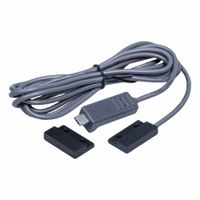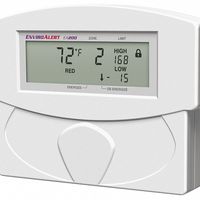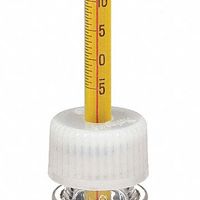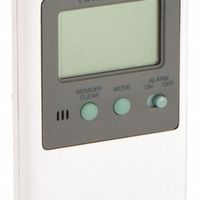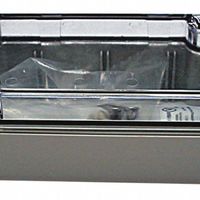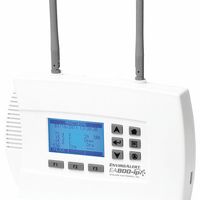Call +(254) 703 030 000 / 751 483 999 / 721 704 777
- Home
- Test Instruments
- Temperature And Environmental Measurement
- Controlled Critical Environment Thermometers Monitoring
.....Read More
Frequently Asked Questions
What is the importance of using controlled critical environment thermometers in hospitals and laboratories?
Controlled critical environment thermometers are essential in hospitals and laboratories for several reasons. They ensure accurate temperature monitoring, which is crucial for maintaining the integrity of sensitive medical and scientific materials. In hospitals, these thermometers help in preserving the efficacy of medications, vaccines, and blood products, which require storage within specific temperature ranges to remain effective. Deviations can lead to compromised patient safety and treatment outcomes.
In laboratories, controlled environment thermometers are vital for ensuring the accuracy and reliability of experimental results. Many biological and chemical reactions are temperature-sensitive, and precise control is necessary to replicate conditions and validate findings. This precision supports compliance with regulatory standards and quality control measures, which are critical for research validity and safety.
Furthermore, these thermometers contribute to infection control by monitoring the temperature in sterilization processes and ensuring that equipment and environments meet hygiene standards. They also play a role in maintaining the comfort and safety of patients and staff by regulating ambient conditions in critical care areas.
Overall, controlled critical environment thermometers are indispensable for safeguarding the quality and safety of healthcare and research activities, ensuring compliance with regulatory requirements, and supporting optimal patient care and scientific integrity.
How do digital critical environment thermometers differ from analog models?
Digital critical environment thermometers differ from analog models in several key ways:
1. **Display and Readability**: Digital thermometers feature electronic displays that provide clear, precise readings, often to a decimal point, enhancing accuracy and readability. Analog models use a dial or mercury column, which can be harder to read and less precise.
2. **Accuracy and Precision**: Digital thermometers generally offer higher accuracy and precision, often with the ability to measure minute temperature changes. Analog thermometers may have a larger margin of error due to mechanical limitations.
3. **Data Logging and Connectivity**: Many digital models come with data logging capabilities, allowing for continuous monitoring and recording of temperature data over time. They can often connect to computers or networks for data analysis. Analog thermometers lack these features.
4. **Alarms and Alerts**: Digital thermometers can be programmed to trigger alarms or alerts when temperatures fall outside a set range, providing immediate notification of critical changes. Analog models do not have this capability.
5. **Calibration and Maintenance**: Digital thermometers often have self-calibration features or can be easily calibrated using software, ensuring ongoing accuracy. Analog thermometers require manual calibration, which can be more time-consuming and less precise.
6. **Durability and Sensitivity**: Digital thermometers are generally more sensitive to environmental changes and can be more durable, as they lack the fragile glass components of some analog models.
7. **Power Source**: Digital thermometers require a power source, such as batteries or electricity, which can be a limitation in some environments. Analog thermometers do not require power, making them more reliable in power-outage situations.
8. **Cost**: Digital thermometers can be more expensive due to their advanced features and technology, while analog models are typically more cost-effective.
These differences make digital thermometers more suitable for environments where precision, data management, and immediate alerts are critical.
What are the common features of critical environment temperature alarms?
Common features of critical environment temperature alarms include:
1. **Real-Time Monitoring**: Continuous tracking of temperature levels to provide immediate alerts when thresholds are breached.
2. **Threshold Settings**: Customizable temperature limits that can be set according to specific requirements of the environment.
3. **Alert Notifications**: Multiple alert methods such as emails, SMS, phone calls, or app notifications to ensure timely awareness of temperature deviations.
4. **Data Logging**: Recording of temperature data over time for analysis and compliance purposes.
5. **Remote Access**: Ability to monitor and manage temperature settings from remote locations via web or mobile applications.
6. **Battery Backup**: Ensures functionality during power outages to maintain monitoring and alert capabilities.
7. **Integration Capabilities**: Compatibility with other systems such as HVAC, building management systems, or IoT platforms for comprehensive environmental control.
8. **User-Friendly Interface**: Intuitive dashboards and controls for easy configuration and monitoring by users.
9. **Scalability**: Ability to expand the system to monitor multiple zones or additional sensors as needed.
10. **Calibration and Maintenance Alerts**: Notifications for sensor calibration and maintenance to ensure accuracy and reliability.
11. **Redundancy Features**: Backup systems or sensors to provide fail-safe operations in case of primary system failure.
12. **Environmental Adaptability**: Suitable for various environments, including cold storage, data centers, laboratories, and industrial settings.
13. **Compliance Support**: Features that help meet industry standards and regulatory requirements for temperature-sensitive environments.
14. **Historical Reporting**: Generation of reports for historical temperature data analysis and audit trails.
15. **User Permissions**: Role-based access control to ensure only authorized personnel can modify settings or access data.
How do you ensure the accuracy of critical environment thermometers?
To ensure the accuracy of critical environment thermometers, follow these steps:
1. **Calibration**: Regularly calibrate thermometers against a standard reference thermometer traceable to national or international standards. Calibration should be performed by accredited laboratories.
2. **Documentation**: Maintain detailed records of calibration, including dates, results, and any adjustments made. This helps track performance over time and ensures compliance with regulatory requirements.
3. **Routine Checks**: Conduct routine checks using ice-point or boiling-point tests to verify accuracy. For ice-point tests, immerse the thermometer in a mixture of ice and water; it should read 0°C (32°F). For boiling-point tests, immerse it in boiling water; it should read 100°C (212°F) at sea level.
4. **Environmental Conditions**: Ensure thermometers are used within their specified operating conditions. Extreme temperatures, humidity, or pressure can affect accuracy.
5. **Proper Handling and Storage**: Handle thermometers carefully to avoid physical damage. Store them in protective cases when not in use to prevent exposure to contaminants or mechanical shock.
6. **Regular Maintenance**: Clean thermometers regularly to prevent residue build-up that can affect readings. Inspect for signs of wear or damage, such as cracks or leaks, and replace if necessary.
7. **Cross-Verification**: Use multiple thermometers to cross-verify readings in critical environments. Discrepancies can indicate a malfunctioning device.
8. **Training**: Ensure personnel are trained in proper thermometer use, calibration, and maintenance procedures to minimize human error.
9. **Software and Firmware Updates**: For digital thermometers, keep software and firmware updated to ensure optimal performance and accuracy.
10. **Manufacturer Guidelines**: Follow the manufacturer's instructions for use, calibration, and maintenance to ensure the thermometer operates as intended.
What are the best practices for monitoring temperature-sensitive samples in laboratories?
1. **Use of Reliable Equipment**: Employ calibrated and validated temperature monitoring devices such as digital data loggers, thermocouples, or infrared thermometers to ensure accurate readings.
2. **Continuous Monitoring**: Implement continuous temperature monitoring systems that provide real-time data and alerts for any deviations from the set temperature range.
3. **Alarm Systems**: Set up alarm systems that notify personnel immediately via SMS, email, or phone call if the temperature goes beyond acceptable limits.
4. **Redundancy**: Use backup power supplies and redundant systems to ensure continuous monitoring during power outages or equipment failures.
5. **Regular Calibration**: Schedule regular calibration of temperature monitoring devices to maintain accuracy and reliability.
6. **Data Logging and Analysis**: Maintain detailed logs of temperature data for analysis and compliance purposes. Use software tools to analyze trends and identify potential issues.
7. **Standard Operating Procedures (SOPs)**: Develop and adhere to SOPs for handling temperature-sensitive samples, including protocols for monitoring, documentation, and response to temperature excursions.
8. **Training**: Provide regular training for laboratory personnel on the importance of temperature monitoring and the correct use of monitoring equipment.
9. **Environmental Controls**: Ensure that laboratory environments are equipped with proper insulation, air conditioning, and humidity control to maintain stable temperatures.
10. **Regular Audits and Inspections**: Conduct regular audits and inspections to ensure compliance with temperature monitoring protocols and identify areas for improvement.
11. **Emergency Response Plan**: Develop and implement an emergency response plan for temperature excursions, including steps for sample preservation and corrective actions.
12. **Compliance with Regulations**: Ensure that temperature monitoring practices comply with relevant industry standards and regulatory requirements, such as those from the FDA or ISO.
How often should critical environment thermometers be calibrated?
Critical environment thermometers should be calibrated at least once a year. However, the frequency can vary based on several factors, including the specific requirements of the environment, the manufacturer's recommendations, and any relevant regulatory or industry standards. In highly sensitive environments, such as pharmaceutical manufacturing, laboratories, or healthcare settings, more frequent calibration may be necessary, potentially every six months or even quarterly, to ensure accuracy and compliance with stringent quality control measures. Additionally, any time a thermometer is subjected to physical shock, extreme temperature changes, or shows signs of inaccuracy, it should be recalibrated immediately. Regular calibration ensures that the thermometers provide precise readings, which is crucial for maintaining the integrity of the environment and the safety of any processes or products involved.
What are the consequences of not maintaining specified temperature ranges in critical environments?
Failure to maintain specified temperature ranges in critical environments can lead to a multitude of adverse consequences:
1. **Equipment Failure**: Sensitive equipment, such as servers in data centers, can overheat, leading to malfunctions or permanent damage. This can result in costly repairs or replacements and significant downtime.
2. **Product Degradation**: In pharmaceutical and food industries, improper temperature control can cause spoilage or degradation of products, leading to financial losses and potential health risks to consumers.
3. **Data Loss**: In IT environments, overheating can cause data corruption or loss, impacting business operations and leading to potential breaches of data integrity.
4. **Safety Hazards**: In environments like laboratories or chemical storage facilities, temperature fluctuations can lead to chemical reactions, posing safety risks to personnel and the facility.
5. **Regulatory Non-compliance**: Many industries are subject to strict regulations regarding temperature control. Non-compliance can result in legal penalties, fines, and damage to reputation.
6. **Energy Inefficiency**: Inconsistent temperature management can lead to increased energy consumption, raising operational costs and environmental impact.
7. **Reduced Lifespan of Assets**: Continuous exposure to inappropriate temperatures can shorten the lifespan of equipment and infrastructure, leading to increased maintenance and replacement costs.
8. **Impact on Research and Development**: In research settings, temperature variations can affect experimental results, leading to inaccurate data and potentially invalidating research findings.
9. **Customer Dissatisfaction**: In retail or service environments, uncomfortable temperatures can deter customers, affecting sales and customer satisfaction.
10. **Operational Disruptions**: In manufacturing, temperature-sensitive processes can be disrupted, affecting production schedules and output quality.
Maintaining specified temperature ranges is crucial to ensure operational efficiency, safety, compliance, and quality across various critical environments.
